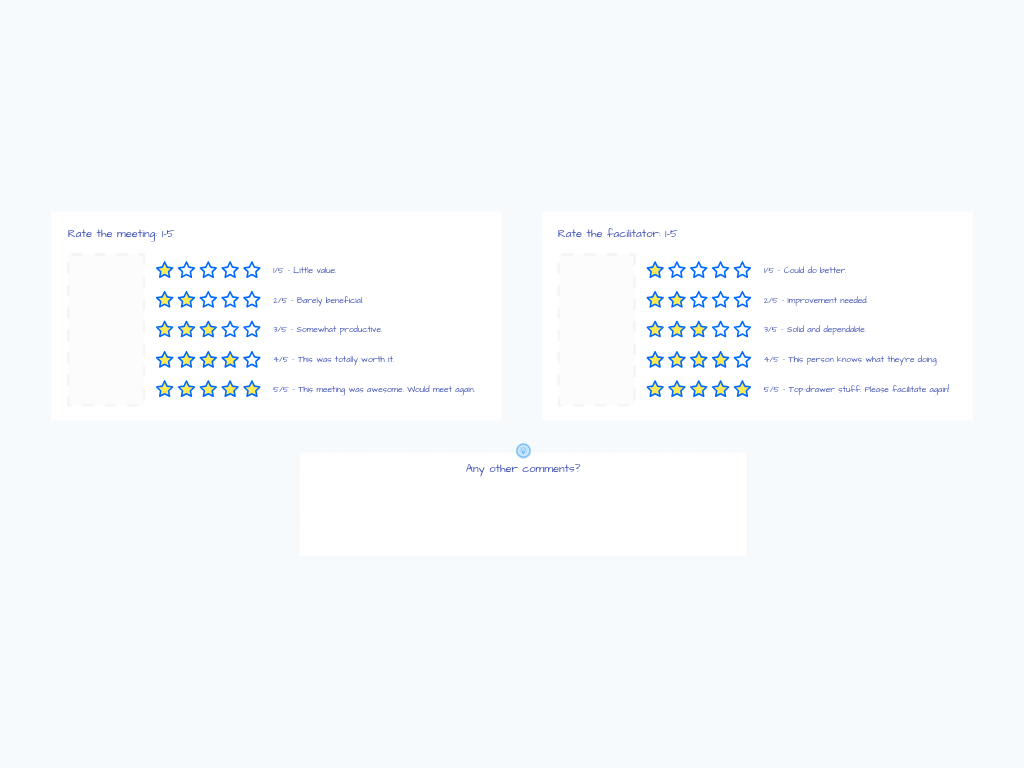ROTI: Treasure - Evaluate Meeting Value with Pirate Booty
The ROTI (Return on Time Invested) Treasure template transforms standard meeting feedback into an engaging treasure-hunting experience. This visual feedback tool helps agile and product teams quickly gauge meeting effectiveness using medieval treasure metaphors, making the retrospective check-out process both memorable and insightful.
What Is ROTI: Treasure?
ROTI: Treasure is a specialized feedback mechanism that replaces traditional numeric ratings with visually appealing treasure graphics. Each treasure pile represents a different level of perceived meeting value - from a single coin (poor use of time) to a king's ransom (extremely valuable session). This creative approach encourages honest feedback while reducing the clinical feel of standard evaluation methods.
The template uses historical currency and treasure terminology to create a playful scale:
- One groat: A single medieval coin representing minimal value
- Tuppence: Two coins, slightly better but still low value
- Thruppence: Three coins, indicating moderate value
- Wedding Dowry: A respectable treasure pile, signifying good value
- King's Ransom: An abundant treasure hoard, representing exceptional value
Benefits & When to Use
This template is particularly effective for:
- Concluding sprint retrospectives to assess meeting effectiveness
- Gathering quick feedback at the end of workshops or planning sessions
- Introducing a fun element to regular team check-outs
- Encouraging participation from team members who might resist standard feedback formats
- Building a historical record of meeting quality over time
Teams benefit from the visual nature of the feedback, which makes patterns immediately apparent and discussions more concrete. The metaphor also creates psychological safety by providing a playful framework for honest feedback.
How to Run a ROTI: Treasure Session
Introduce the template (1 minute)
- Present the treasure metaphor at the end of your meeting
- Explain the question: "How valuable was this meeting?"
Explain the rating scale (2 minutes)
- Clarify what each treasure level represents in terms of meeting value
- One groat = "Waste of time"
- Tuppence = "Some small value"
- Thruppence = "Moderately useful"
- Wedding Dowry = "Very valuable"
- King's Ransom = "Exceptional use of time"
Collect participant feedback (3-5 minutes)
- Ask participants to add sticky notes with their names (or anonymously) under their chosen treasure level
- Invite optional written comments explaining their rating
Review the results (3-5 minutes)
- Acknowledge the distribution of feedback
- For meetings with predominantly low ratings, discuss improvement opportunities
- For highly rated meetings, identify what made them successful
Commit to actions (2-3 minutes)
- Based on feedback, identify 1-2 concrete changes for future meetings
- Document these commitments in your team's action item list
Tips for a Successful ROTI: Treasure Session
- Keep the process quick and lightweight—aim for 10 minutes or less
- Create psychological safety by adding your own rating first
- Consider collecting anonymous feedback if your team is still building trust
- When receiving low ratings, respond with curiosity rather than defensiveness
- Compare results over time to track improvement in meeting effectiveness
- For remote teams, encourage participants to briefly explain their ratings verbally
- Use the results to adjust meeting formats, frequency, or participant lists
By turning meeting evaluation into a treasure hunt, you'll likely see increased participation and more honest feedback, ultimately leading to more effective meetings that truly deliver value to your team.



